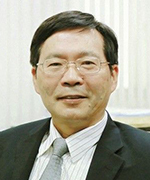
|
 |
蔡明道院士 |
講題:New Horizon in Enzymology from Cryo-EM and X-ray Free-electron Laser (XFEL)
冷凍電子顯微鏡(Cryo-EM)與X光自由電子雷射(XFEL)帶給酵素學的新視野 |
 |
Structural determination of enzymes has been an integral part of mechanistic enzymology. However, the two common approaches, X-ray crystallography and nuclear magnetic resonance (NMR), can only be obtained at specific conditions, whereas mechanistic analysis often covers a broad range of conditions. These limitations are being overcome by two emerging structural biology techniques: Cryo-EM can facilitate structural determination at multiple solution conditions with various intermediate complexes, while XFEL allows determination of multiple intermediate structures at ultrashort time intervals. In this lecture I will illustrate applications of the conventional X-ray crystallography and NMR to the study of DNA polymerases, the modern high-resolution cryo-EM to the mechanism of ketol-acid reductoisomerase (KARI), and the emerging XFEL to the photoreduction mechanism of a DNA photolyase.
酵素結構一直以來都是機制酵素學不可或缺的內容,但X光晶體學與核磁共振(NMR)這兩種常用的研究方法皆受限於特定的實驗條件,而反應機制分析往往包含廣泛的實驗條件。這些限制因著兩個新興結構生物學技術的發展將得以突破,一是冷凍電顯技術,可在多項液態條件下解出複合物結構;另一是XFEL,可在極短時間內解出酵素結構。此次演講中,我將分別以DNA聚合酶為例闡釋傳統X光晶體學與NMR的應用、以酮醇酸還原異構酶(KARI)機制為例闡釋冷凍電顯技術的應用、並以DNA 光裂合酶的光還原機制為例,闡釋XFEL的應用。
|
|
鄭建鴻院士 |
講題:Metal-Catalyzed C-H Functionalization for the Direct Synthesis of Pyridinium-Type Compounds and Their Application |
 |
Quaternary ammonium salts and their derivatives are found in many natural products and are known for their diverse biological activities including antimalarial, anti-arrhythmic, antitumor, inhibitory, antileukemia, antibacterial, anti-inflammatory, and cytotoxicity. However, almost no direct methods are known for the synthesis of the salts. We have developed several methods for the synthesis of a wide range of quaternary ammonium salts using transition metal complexes as the catalysts. Earlier, we observed a nickel-catalyzed regioselective synthesis of substituted isoquinolinium halides from o-halobenzaldehydes, amines and alkynes in an atom economy fashion (eq 1).1 The isoquinolinium salts can be readily converted to the corresponding isoquinolones for further applications. Next, we employed benzaldehydes, amines and alkynes via Rh(III)- or Co(III) catalyzed C-H activation to make similar isoquinolinium salts (eqs 22 and 3). Some natural products can be readily prepared by the catalytic reactions.3 Very recently, we used Cu(II) salt and dioxygen as the oxidizing catalyst and reagent for the synthesis of quinolinium salts from anilines, aldehydes and ketone (or alkynes) and an acid (see eq 4).




|
|
孫天心院士 |
講題:Evidentiality As Information-access Marking: Evidence from Tibetic |
 |
Evidentiality, a cross-linguistically common category of verbal inflection, is classically defined as ‘obligatory linguistic marking of information source’ (e.g. Aikhenvald 2004). On a competing view (Tournadre and LaPolla 2014), evidentiality is construed rather in terms of cognitive access. In this talk, I draw on primary data from Takhog, a Tibetic language of Sichuan with an elaborate set of evidential distinctions marked consistently by a suffixal paradign, to demonstrate that (a) the egophoric or performative (Oswalt 1986) evidential is an integral component in the Tibetic evidential system, and (b) the full intricacies of Takhog evidentials can be intuitively analyzed in terms of cognitive access to information, with only minimal reference to information channels.
|
| |

